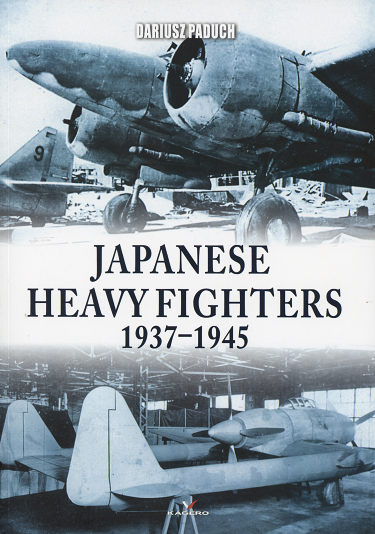Kagero's Japanese Heavy Fighters 1937-1945
 The
concept of the heavy fighter was one that was frequently visited by many
nations. The concept was that it would be able to perform any number of
missions, from escorting bombers to performing reconnaissance to operating as a
ground attack aircraft and even a light bomber. Some of the key requirements is
that it have decent range and be fast enough to deal with enemy fighters. This
generally meant a twin engine aircraft. Prior to the start of WWII, the only
nation that actually put one into operational use was Germany with its Bf-110.
However, the Japanese were not far behind.
The
concept of the heavy fighter was one that was frequently visited by many
nations. The concept was that it would be able to perform any number of
missions, from escorting bombers to performing reconnaissance to operating as a
ground attack aircraft and even a light bomber. Some of the key requirements is
that it have decent range and be fast enough to deal with enemy fighters. This
generally meant a twin engine aircraft. Prior to the start of WWII, the only
nation that actually put one into operational use was Germany with its Bf-110.
However, the Japanese were not far behind.
For the Japanese, the idea was similar to the 110, in
that it would be able to escort bombers to the target. Their experience in China
with unescorted bombers showed that an escort fighter was a priority. This began
the development of the Ki-45 an aircraft that from the start, was shown to be
fairly incapable of holding its own against single engine fighter opposition.
However, like the 110, it was developed into other aircraft that were more
capable and were able to function in a different role from what was initially
envisioned. This role being a bomber destroyer.
Both the Japanese army and the Japanese navy were able
to produce a series of twins that proved to be capable reconnaissance platforms
and to some extent night fighters, even though designed as a heavy air to air
fighter. The main navy type was the J1N1. Others that operated as heavy fighters
were variants of the Ki-46, the Ki-67 and the P1Y2. Not all types converted were
twin engine, though all were relatively large planes.
The book is divided into three main categories. One is
IJAAF planes, the second is IJNAF planes and the third is Japanese aircraft
weapons. The planes involved are not only production types, but also
experimental aircraft that for what ever reason (usually the end of the war) did
not make it out of the prototype stage. There are also aircraft within that
didn't make it past mock-ups and those that were simply envisioned and rejected
either because of a lack of technical capabilities or a lack of feasibility.
To be sure, there are a number of entries that I don't
really consider a heavy fighter like the J8M or the J7W, but their full
development and history are included. I was also pleased to see that there were
quite a few photos that I'd not seen before, a real nice surprise. The author
has done a very good job of telling the stories of thes aircraft and as such,
has produced a superb reference on the subject and on late war prototypes. It is
a book that I enjoyed reading and one that I can quite easily recommend to you.
June 2022
Copyright ModelingMadness.com. All rights reserved. No
reproduction in part or in whole without express permission.
Thanks to
Casemate Publishers for the review book. You can get yours today
at this
link.
If you would like your product reviewed fairly and
fairly quickly, please contact
the editor or see other details in the Note to
Contributors.
 The
concept of the heavy fighter was one that was frequently visited by many
nations. The concept was that it would be able to perform any number of
missions, from escorting bombers to performing reconnaissance to operating as a
ground attack aircraft and even a light bomber. Some of the key requirements is
that it have decent range and be fast enough to deal with enemy fighters. This
generally meant a twin engine aircraft. Prior to the start of WWII, the only
nation that actually put one into operational use was Germany with its Bf-110.
However, the Japanese were not far behind.
The
concept of the heavy fighter was one that was frequently visited by many
nations. The concept was that it would be able to perform any number of
missions, from escorting bombers to performing reconnaissance to operating as a
ground attack aircraft and even a light bomber. Some of the key requirements is
that it have decent range and be fast enough to deal with enemy fighters. This
generally meant a twin engine aircraft. Prior to the start of WWII, the only
nation that actually put one into operational use was Germany with its Bf-110.
However, the Japanese were not far behind.